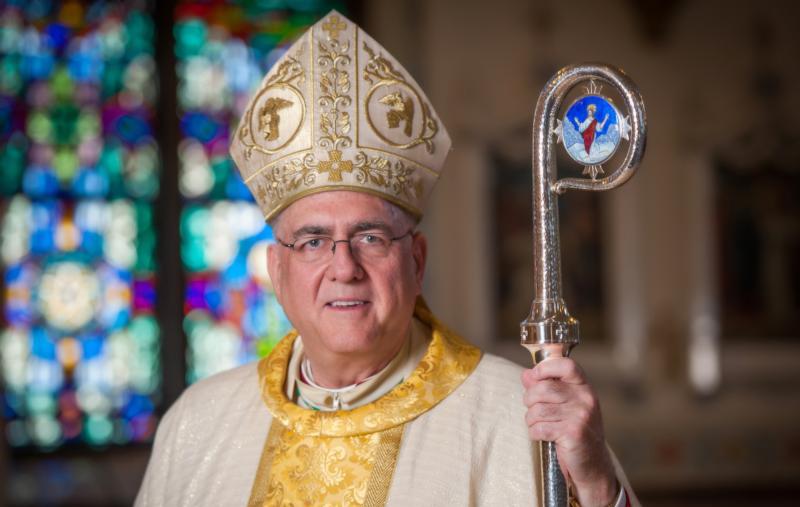
by Archbishop Joseph F. Naumann
November is a month in which the church invites us to remember and pray for those who have died.
In the bottom portion of the windows in the chapel at my residence are the coats of arms of the bishops who preceded me in shepherding the Catholic Church in northeast Kansas. Coats of arms can be traced back to the 11th century. They are shields with symbols and a motto that represent a particular family, individual or institution.
The first bishop of what eventually became the Archdiocese of Kansas City in Kansas was John Baptist Miege. He was born on Sept. 18, 1815, in Savoy.
The Duchy of Savoy encompassed areas claimed by both France and Italy. At the age of 21, he entered the Jesuit novitiate. In 1838, he professed his first vows. Just a few days before his 32nd birthday, Miege was ordained a priest. In 1849, Father Miege was sent to the United States, where he served briefly as a pastor in St. Charles, Missouri, and then as a professor of moral theology at St. Louis University.
In 1850, Father Miege was appointed by Pope Pius IX as the first bishop of the Ecclesiastical Territory East of the Rocky Mountains. According to legend, he ignored the Holy Father’s letter of appointment, because he thought it was a prank devised by his fellow Jesuits.
When much to his surprise and dismay he discovered the letter was authentic, Father Miege declined the appointment. He wrote to his brother, who was a priest in France, that he would never have come to the United States had he known this might happen. He shared with his brother that he would have remained in Europe, where they knew him too well to make such a mistake.
Father Miege acknowledged that he could barely take care of his own soul, much less be responsible for so many others. Eventually, he was convinced by his Jesuit superiors that the church needed him to accept this responsibility.
The territory for which he was responsible extended west to the Rocky Mountains and as far north as the Canadian border. The mission was to serve the Native Americans for which the new bishop had a great passion.
At the age of 35, Father Miege was consecrated a bishop on the solemnity of the Annunciation (March 25, 1851) in St. Francis Xavier College Church in St. Louis.
The vast territory for which he was responsible included a good portion of Colorado, all of the Dakotas, Kansas, Montana, Nebraska and Wyoming. There were, however, only five churches, eight priests and approximately 5,000 Catholics. He built what was termed a “log cabin cathedral” in St. Marys, Kansas, near a major Potawatomi settlement.
In 1854, with the congressional passage of the Kansas-Nebraska Act, ending the Missouri Compromise, a wave of new settlers began arriving in Kansas.
Bishop Miege moved his base of operation to Leavenworth where he would eventually build in 1868 a large cathedral dedicated to Mary under her title, the Immaculate Conception. Bishop Miege traveled to South America to raise funds to reduce the debt incurred from the construction of the cathedral. In 1869, he traveled to Rome to participate in the First Vatican Council.
Bishop Miege led the church in Kansas through the tumultuous time of the Civil War, as well as through the turbulent late 1850s, often referred to as the era of Bleeding Kansas because of the violent confrontations between the anti-slavery and pro-slavery forces.
Bishop Miege was allowed to retire from his episcopal responsibilities in November 1874. At the time of his retirement, there were 71 parishes that were being served by 48 priests.
During the first couple of years of retirement, Bishop Miege was granted his wish to serve as a spiritual director for some of the Jesuit novices in Maryland. However, at the request of his Jesuit community, Bishop Miege went to Detroit to found and become the first president of Detroit College that is today the University of Detroit.
I am very grateful for Bishop Miege and all my episcopal predecessors. It is amazing all that the Holy Spirit was able to accomplish under their leadership and with the cooperation, support, zeal and generosity of the priests, religious and laity.
We should pray for Kansas’ ancestors in the faith, giving thanks to God for their dedication, as well as seeking their intercession as we strive to build upon the foundation that they laid for a vibrant Catholic community.
I trust that Bishop Miege is pleased with the amazing high school that bears his name. I recently celebrated Mass with members and benefactors of the Bishop Miege High School Foundation that provides tuition assistance to many families of Bishop Miege students. The foundation is currently working at building an endowment to insure financial assistance for future generations.
During November, let us remember with gratitude all those who were instrumental with the establishment and development of the Catholic Church in Kansas.
Let us pray for all those who made it possible, not just to know about Jesus, but actually to encounter Our Lord and develop a friendship with him. Let us give thanks for the great gift of the beauty and wisdom of our Catholic faith.
Let us seek their intercession that we will imitate their zeal and generosity in passing on to future generations the gift of our Catholic faith and making it possible for them to be part of this amazing worldwide family of faith.

